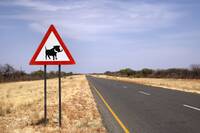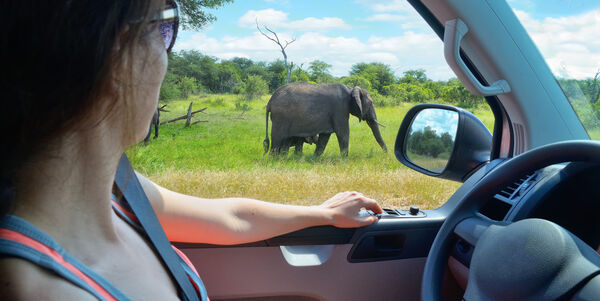Namibia's roads will take you to areas of outstanding beauty and wonder. Follow our guide to Namibia’s road rules and regulations to make your driving holiday safer and more enjoyable.
Do I need an international driver’s licence to drive in Namibia?
Not necessarily, though it is advisable. If you wish to drive in Namibia you will need a valid driving license, and you must carry it on you when you are driving. If your licence is not written in English, it is advisable to travel with an international driver’s license.
What side of the road do Namibians drive on?
You drive on the left-hand side of a two way road in Namibia. Ask passengers to remind you over this every time you set off, and when you are turning at an intersection. You should always use pedestrian crossings where possible and remember to look right, then left, and then right again when you are walking across a street.
On gravel roads, you may find it easier to simply chose the best path along the road than trying to stick to a single lane. Exercise caution at all times whilst doing this and make sure you pay attention to the road and area around you, especially as other drivers may well be doing the same.
Do I have to wear a seat belt?
Yes. The driver, as well as any and all passengers must wear a seatbelt.
Are there speed limits in Namibia?
Yes, the national speed limit on tarred roads is 120 km/h, and 80 km/h on gravel. Excessive speed is the main cause of traffic accidents so sticking to sensible speeds below these limits is imperative, especially on the gravel tracks.
What are the road conditions in Namibia?
There are tarred and gravel paths through Namibia, and caution must be practiced at all times. Road signs are good indication of upcoming road conditions, so take particular note of these. When signs indicate a gentle turn, it is suggested that you reduce your cruising speed by a third before taking it, when they indicate a sharp turn, it is advisable to reduce your speed by at least one half to ensure your safety.
Maintain focus whilst driving at all times – gravel roads can cause dusty conditions and obscure vision. In these conditions, drive with your lights on and be careful of any obstructions in the roads, rocks or wildlife by be hidden and cause accidently. Practice gentle breaking on these gravel tracks, sudden or heavy breaking can cause skidding and loss of control. Maintain a safe distance from the driver in front and avoid overtaking where possible.
Special care must be taken if you are travelling during the rainy season; road conditions become particularly bad and even tarred main roads can be prone to substantial flooding and damage.

Is there wildlife on the roads?
Absolutely! It is important to take animal warning signs seriously – domestic animals wander into roads regularly however warthogs, kudus and even elephants are known to cause significant problems. Watch out for placid appearing animals grazing at the road-side; wild and even domestic animals spook easily and may jump or run in front of the vehicle.
Some wildlife is more active at night, so if at all possible avoid driving after dark. Kudus are especially known for leaping into the path of oncoming traffic at night, and other hazards are more difficult to see after sundown.
What should I bring?
As a general rule, make sure you bring all food requirements to last your stay. Take at least 20 litres of water per person, preferably more; if you’re travelling to more rural and desert destinations, try to carry between 50 and 100 litres.
It’s also important to pack a medical aid kit. In the heat and humidity of Namibia, even the smallest cuts can get infected quickly, so even a basic medical aid kit is invaluable.
An up to date and well detailed map is essential as there may not be road signs to direct you back to your path, especially in more rural areas.
